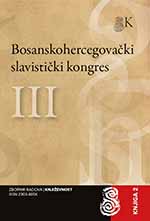Хронотоп Сараева в прозе Александра Хемона (на материале романа Nowhere man)
Chronotope of Sarajevo in Alexandar Hemon’s prose (based on the novel Nowhere man)
Author(s): Polina ZenovskayaSubject(s): Language and Literature Studies, Studies of Literature, Bosnian Literature
Published by: Slavistički komitet BiH
Keywords: chronotope; migrant literature; mythologem; world model; narrative space; narrative time;
Summary/Abstract: In the research we consider that the chronotope is the optimal term for describing the time and space relation as it enables to draw attention to the intrinsic connection between the movements in space within the text and the time. The large scale of internationality in the Nowhere Man allowed the author to picture the country without wistfulness that is typical for the emigrant prose. Idealization of a hometown image is not due to the nostalgy for place but time. The novel is intended for the foreign reader and it represents Sarajevo as a point in space and time that was ideal to spend the adolescence and understand that life has no limits. The chapters dedicated to Sarajevo lack the emotional descriptions, exact details and names of places that the reader cannot relate to because of different experience. The fact that concept of home as one of the mythologems is missing also supports the reasoning behind the title of the novel. Conversely, in his columns for the Dani magazine Aleksandar Hemon treats the chronotope differently. The chronotope of Sarajevo almost does not have the time marks and at the same time the exact places in space are meticulously defined as they are supposed to be meaningful for the audience. This allows the author to show it as timeless and support the mythology connected to the image of the city.
Journal: Bosanskohercegovački slavistički kongres
- Issue Year: III/2022
- Issue No: 2
- Page Range: 85-94
- Page Count: 10
- Language: Russian

